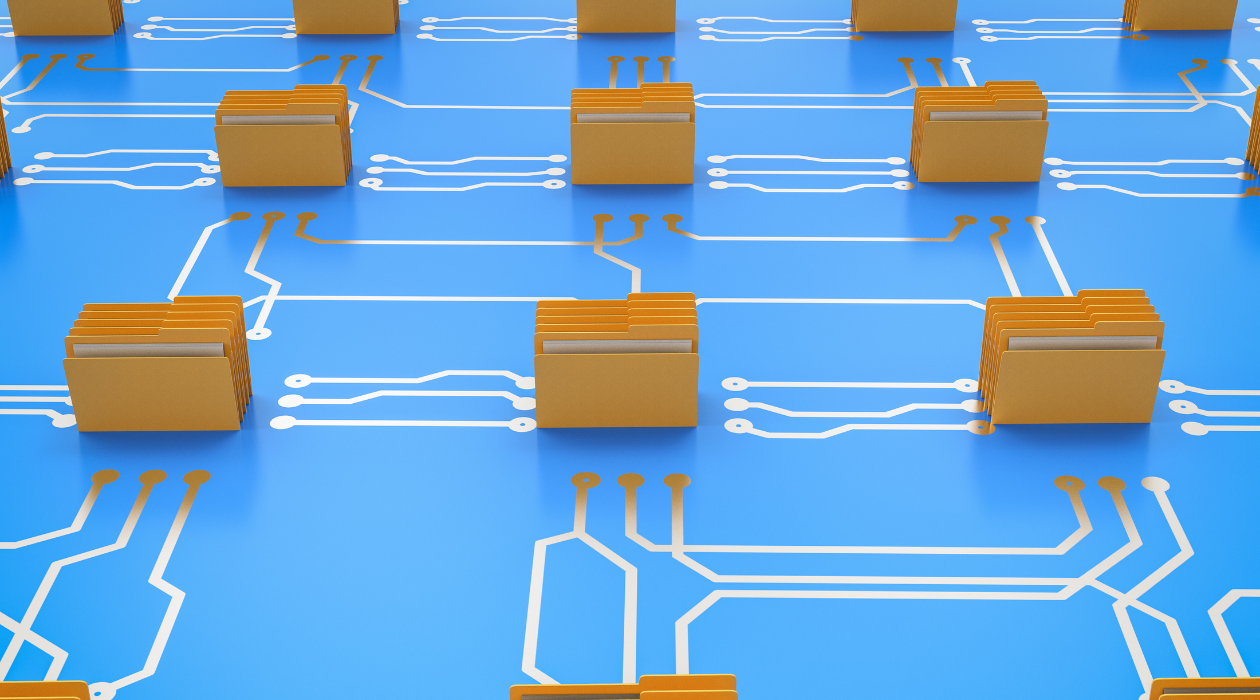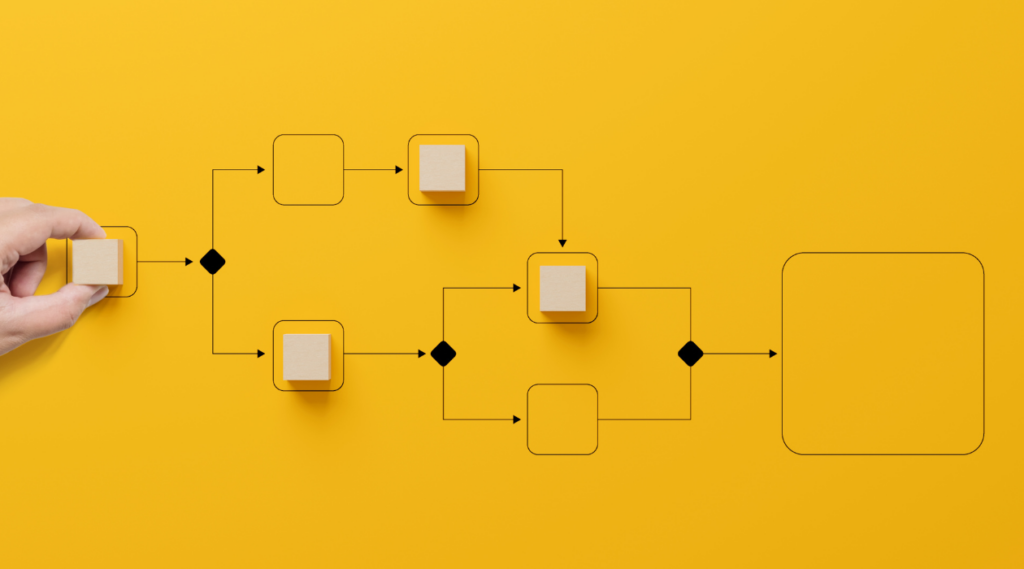The Brief
As part of the NSW State Governments Open Data Initiative, Experience Digital was contracted to perform data migration from legacy government databases. These databases housed the geographic semantic data of the Geospatial Services systems – the same systems that ambulances and police use.
The Open Data Initiative required that we use open source technology for data at rest (storage). The source data was stored in a relational model, so we didn’t need to use more exotic modelling solutions like graph, document, or multi-mode databases. We selected PostgreSQL, a venerable relational database, as our backing store. After working on this type of project for over a decade, we believe that PostgreSQL is the best relational database available.
The work required us to migrate three independent databases from proprietary IBM relational technology to an open source data store. We then had to massage the data to form part of an application rebuild. The three source databases were Db2 and Informix, and they were hosted in a government data center behind a firewall. We accessed them through a VPN connection to a jump box/bastion server, which had read access to the databases.
The data in the databases was generally compatible with PostgreSQL, with the exception of some opaque custom types in the Informix database. The source code for these types was long lost, so we had to work with random bytes. Fortunately, the data in these types was very sparse, so the client decided not to migrate them.
As one of the first projects under the Open Data Initiative, we encountered a number of challenges, such as difficulties accessing the VPN and sudden downtime of databases.
Although these issues were inconvenient, they were not unforeseen. The DFSI Spatial Services IT team was collaborative and helpful in addressing these challenges. As this was a pioneering project, we knew there would be some obstacles as access, identity, policy, and infrastructure were tailored to this new environment.
Our Approach
Experience.Digital chose open source tools like SQLAlchemy and Python to ensure that the migration tool could be repeatable. This meant that anyone could rerun the work exactly as Experience.Digital did, unencumbered by licensing or feature issues.
These are some of the advantages:
- DBAPI wrappers were available for Informix, Db2 and Postgres drivers
- SQLAlchemy relational mappers were available for Db2 and Postgres connections.
- We could control both the schema modification and ETL-style pipeline using the same constructs
- The Alembic migrator provides powerful abstractions and let us generalise schema updates, especially when implementing the temporal and version triggers on the content tables. (more on this below)
- The schema reflection capabilities of SQLAlchemy saved us a significant amount of time of hand crafting schema representations.
We investigated using other technologies, but they were too specialised and required us to use multiple disparate tools. We decided to limit the data type conversions to a single well-understood runtime (Python and Postgres) instead.
We also considered jOOQ, an open source tool that is similar to SQLAlchemy but offers stronger typing by using Java or Kotlin. However, its Informix and Db2 integration are licensed, which made it not a viable option for our project.
Data Processing Pipeline
The solution was implemented using a three-phase approach. The first step was essentially a giant reflection-via-schema-metadata operation. The second step was a convert-and-clone process where we de-serialised Informix and Db2 data types into native Python objects and re-serialised them back into Postgres data types. The third step was a schema merge operation, where we combine three separate databases into a unified final product.
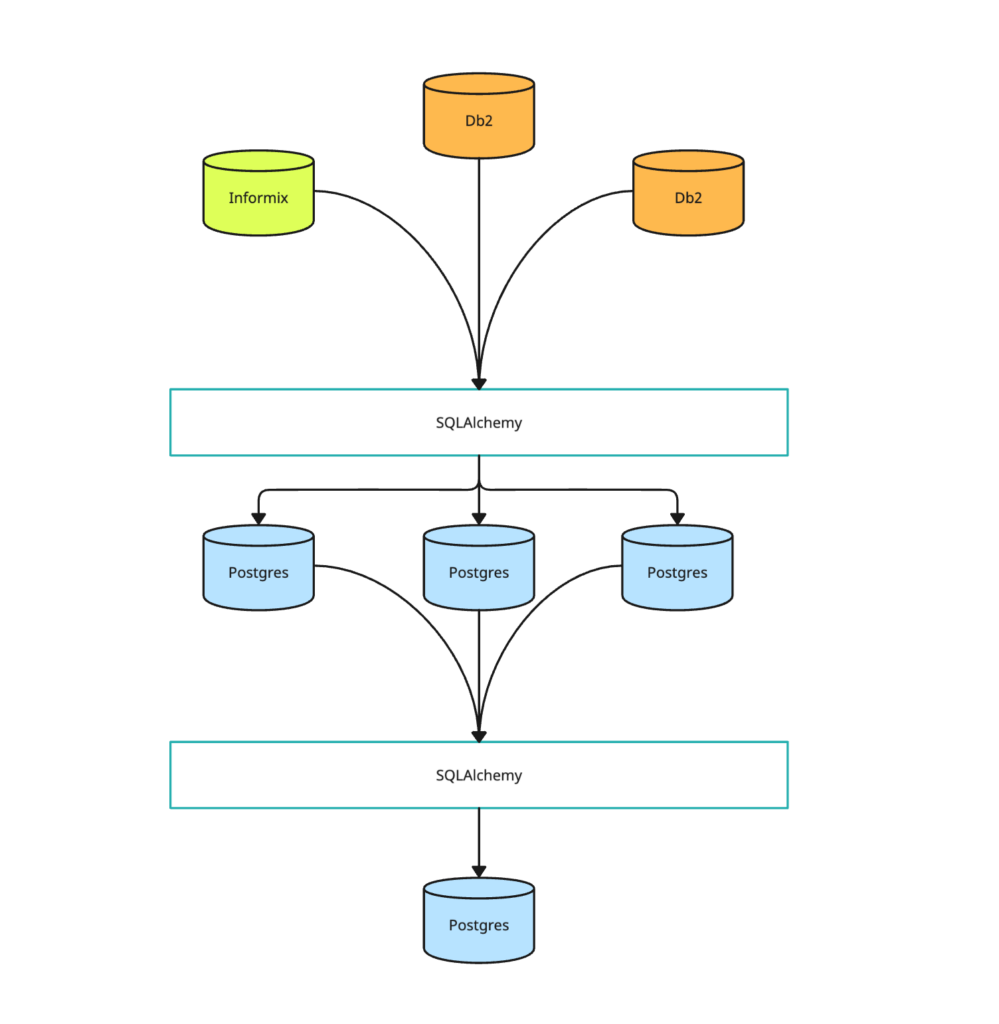
We used an SQLAlchemy layer to develop the solution in a consistent working environment across three different hosts, seven different database instances, and three different database types. This was an invaluable decision, as it allowed us to easily manage the complexity of the project.
Phase 1 – Schema Reflection
We heavily utilised the Alembic migrator for this step. Alembic can generate out mapped python classes that directly correlate to a database it is looking at. It essentially converts reflected schema data into a python class representation.
In this contrived example it looks a bit like this:
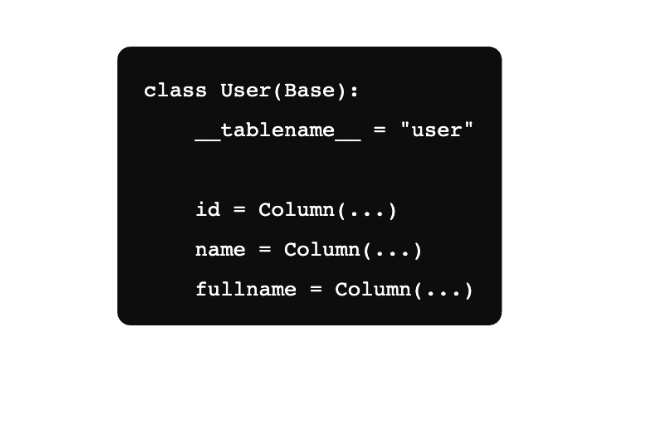
Generating 400+ type-compatible classes from an existing database was a lifesaver. We took inspiration from “The Art of Unix Programming” and the “Rule of Generation”:
“Avoid hand-hacking; write programs to write programs when you can. Generated code is almost always cheaper and more reliable than hand-hacked.”
We agree. This is a clear example of how using code to create code can save time and effort.
The second part of the magic trick was using Alembic’s DSL to generate backend-specific schema code from its Python implementation. Alembic had already given us the structure of the tables, so we just switched out its backend implementation and let it do the heavy lifting. The below example shows how we can use a generic Python class with a different Integer type for Informix vs Postgres.

We used Alembic to generate type-compatible migrations for each table in the Informix and Db2 databases. We then applied the migrations to a Postgres database, with a few custom converters for Db2 field types with no 1-1 mapping to Postgres. This resulted in perfect 1-1 schema mapping for all 600 tables across the three databases.
Phase 2 – Convert and Clone
Our initial attempt at data conversion involved accessing the source databases, doing bulk conversion in Python and writing it to the destination. This proved to be ineffective for a variety of reasons, especially as we started getting complaints we were affecting production performance. We also had a particularly frustrating character set issue on one of the Db2 databases that affected <10 rows out of the millions in it. This issue would cause an entire transaction to abort after 45 minutes.
Our initial solution was not scalable, so we re-engineered our process to clone each database into Postgres first. Since we had a direct 1-1 schema mapping, we had to obey the constraints in the source database. This meant starting with tables with no foreign key dependencies and working backwards. This approach allowed us to identify and fix character set issues in an isolated transaction, without losing previous work.
We also had to manipulate the primary keys to match the foreign constraints, which is a common task in database migrations.
Phase 3 – Database Convergence
At this stage, we had three separate databases with 100% data clones. Since Experience.Digital was also doing the application rebuild, this was a modelling activity.
SQLAlchemy was an invaluable tool for this work. Although it required more upfront effort than other tools, the standardised operating environment allowed us to quickly develop a solution once the boilerplate was done. The standardised representation in a Python REPL allowed us to quickly identify and live-test conversion issues. This was especially helpful when troubleshooting issues with large batches of data.
Temporal Mapping
The other major component of this work entailed creating a version-control system in the database. The constraints added were:
- A timestamped version of every record in the database
- Temporally contiguous time range for updates (ie no holes)
Instead of implementing this in the application code, we implemented it in the database. Many people treat databases as just a storage layer with some validators, but we recognize them as a complete system to be used. We leveraged triggers to implement this feature and created the following model:

Every record in every table has a mandatory version_id foreign key, which in turn has an associated resource_id key. We wrote triggers to hook into the UPDATE and INSERT actions. When a record was updated or inserted, the triggers serialised the NEW representation to JSON using row_to_json() and wrote the record into a version table.
Writing the same 4 trigger functions for hundreds of tables is brittle and error-prone, so we leveraged the power of Python metaprogramming and the in-memory schema representation of SQLAlchemy to automatically generate and flush a CREATE TRIGGER clause for each trigger for each table.
Records could be deserialized back into the native Postgres record type by using the json_to_row() function. The ::<TYPE> cast on the function used internal Postgres reflection work to deserialize the contents to the correct Postgres record primitives.
This allowed a completely automated version control process to run, and allowed it to run independently of any application accessing it. Ensuring domain rules exist in their properly-bounded context is a design principle that we often see overlooked (often due to perceived complexity), but by using the correct tools, much richer outcomes can be achieved for only a minimally more upfront effort.
The Outcome
To put some context to the results, we migrated hundreds of tables, thousands of triggers, and millions and millions of records from legacy government databases to an open source data store. We achieved this by writing custom code that was tailored to our specific requirements. We also created an entirely automatic, self-contained versioning system that requires no manual work or specialized knowledge to operate. This was all made possible by using open source tooling and a drive to do it right.
The scale and complexity of this project was unprecedented. However, by taking the time to understand the problem and choose the right tools, we were able to successfully complete the project on time and within budget.
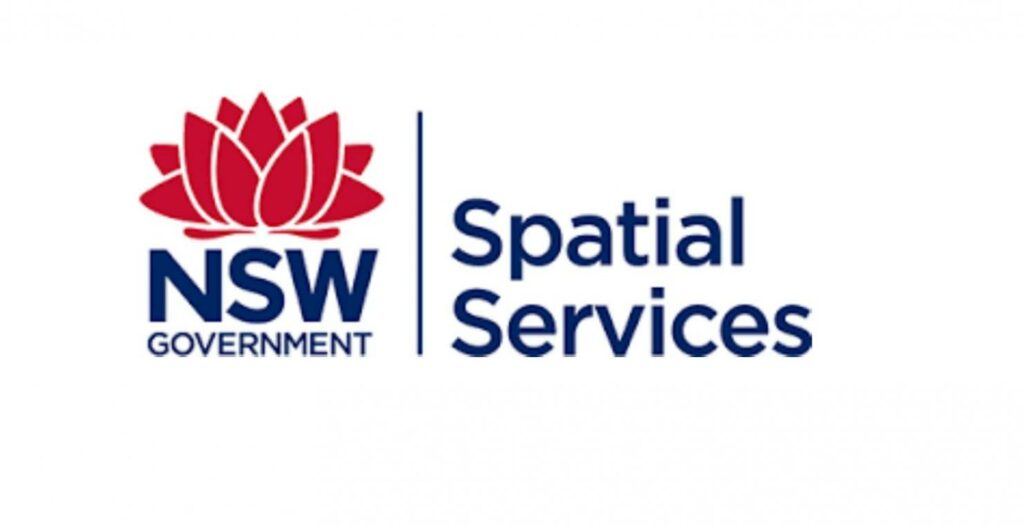
About
Spatial Services (DFSI), a division of the Department of Customer Service, plays the central role in New South Wales Government’s spatial and land information services. Their authoritative data products provide the foundation for NSW’s mapping and spatial information systems and are used for building better services across the community, government, industry and the environmental sectors.
Authoritative spatial and land information is a vital tool that enables the community, business and government to derive maximum benefit from land and property information to generate economic growth and prosperity. Spatial information is also increasingly used for socio-economic and demographic initiatives.
“We needed a service provider to gain a deep understanding of the challenges we were facing, and to assist us to build a new service that would firstly, overcome those challenges so we could do a lot more than we were previously able, and then provide a platform upon which we could execute some of the key strategic objectives we had for the near and mid-term future. Crucially all of this needed to happen without any business interruption. The team achieved that with aplomb, and we are incredibly appreciative of the role their AWS skills and expertise played in the success of the project.” – Christian Dowling, Senior Project Manager.
About Experience Digital
Enabling businesses to thrive in the Digital Era.
Experience Digital is a trusted national digital software, data, automation, and systems integration house that has vast experience in assisting clients to transition to a digital future.
More Success Stories
Healthcare Facility Capacity Prediction
BaptistCare is a not-for-profit, Christian-based care organisation providing aged care, in-home support, and community services across NSW, ACT, and WA, supporting over 24,000 individuals with a dedicated team focused on
Bringing Data Together for Sales Tracking
Oestergaard is a global leader in rendering solutions, specialising in processing equipment for the meat and fish by-products industry. With 25 years of experience, they offer expert knowledge and technology
Modernising Estate Planning with Pax Animi
Discover how Experience Digital partnered with Pax Animi to enhance user experience and modernize the estate planning process in Australia.
MedHealth’s Purpose-Built Assessment Tool Created Using AWS Lambda
MedHealth is a broad set of industry-leading health, medical, and employment brands in the government and private health sector designed to deliver the best possible health and employment outcomes.
Redesigning the NSW Spatial Services System for a Better User Experience
How did Experience Digital's user-centered design approach improve the user experience of the NSW Spatial Services system?
NSW Spatial Services Streamlined Their Workflows with a Customised App
Leveraging Jira's power as a workflow engine, we built a customised app on Typescript to streamline internal business processes and increase efficiency.
SkyMesh’s Journey with Microsoft Dynamics 365 to Combat Churn
SkyMesh saw a 90% reduction in churn cases after implementing Microsoft Dynamics 365. Learn how you can achieve the same results for your business.
Securely Launching Mitti’s Risk Platform with AWS Cloud Solutions
Mitti is a tech-led, data-driven insurance company aiming to challenge the traditional insurance model for small to medium businesses, focusing on risk mitigation to reduce the likelihood of ever needing
NSW Spatial Services Takes the Leap to the Cloud
With help from Experience Digital, NSW Spatial Services modernized their legacy systems with microservices architecture, improving scalability, security, and maintainability.
